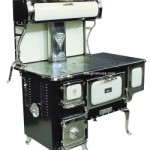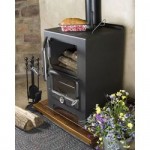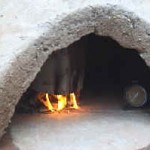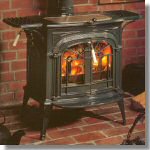by Catherine Haug, February 22, 2011
(photo from AntiqueStoves.com)
We are planning a future event on baking bread without electricity or gas, and are looking for a presenter who can talk about baking on top of a wood heating stove and in a wood range oven. If you are interested, or know of someone who has this experience, please contact Catherine (Cat).
I have some experience with an old homesteader’s wood range, but that was years ago. I’ve never tried to bake bread on top of my wood heating stove, but may just give it a try and then update this post with photos and text of the process I used.
Meanwhile, here’s what I’ve gleaned from researching the topic on the web,, and from my own limited experience:
Baking in a Wood-Heated Oven
Equipment:
You can use glass or metal bread pans, lead-free stoneware or tempered glass bowls or baking dishes, or a flat baking sheet/baking stones for free-form loaves. You might also want to invest in a good oven thermometer.
Method:
For wood-burning ranges and heating/cooking stoves, you stoke the fire and monitor the internal oven temperature until it reaches desired temperature range (350 – 400º F), then maintain the coals to maintain temperature while the bread bakes in the oven.
There are, however, a few difference or points to consider, depending on the type of wood stove.
- Wood heating/baking stoves (see photo from Lehman’s, above right) typically have the firebox above the oven, so that the oven is heated from above (unlike electric/gas ovens which are heated from below). Such stoves are wonderful for baking pizza and rustic breads with that special crunchy crust.
- Wood ranges (see photo at top of article) typically have the firebox to one side of the range, next to the oven. Heat channels between the stove top and the oven, heat the oven from above. These ovens tend to be hottest on the side nearest the firebox, and toward the top of the oven.
Wood-fired brick or cob ovens
(photo, left, from InnerExplorations.com)
These ovens work differently, by taking advantage of radiant heat. Keep a fire burning hot in the oven until its inside walls are white-hot. Then damper the stove to let the fire burn to ash. Remove the ash (or move it to one side), then bake on the floor of the oven, with the hot radiant walls providing the heat.
These ovens are the best for old-world style breads, pizza, etc., but can also be used for baking tasks that require less heat such as:
- slow-roasting meats
- dehydrating fruits, mushrooms, herbs, etc.
- drying wet or poorly seasoned wood for the next fire
See traditionaloven.com and MotherEarthNews.com for more.
Baking on Top of a Wood Heating Stove
(photo of Intrepid woodstove, right from Midwest Pool & Spa, and Dutch oven, below, from Amazon)
Equipment:
The idea is to create an oven atmosphere on top of your stove, using a container large enough to contain your free-form loaf, or shaped loaves in bowls/pans. For example, a cast iron Dutch oven, roasting pan, or other large suitable covered container that can sit on top of your stove. Another method uses trivets and a large overturned metal bowl.
For the loaves, you can use lead-free earthenware, tempered glass, or metal bowls or baking pans, muffin tins, etc.. Or bake free-form on the bottom of the Dutch oven, or on baking sheets.
See also my post: Dutch Oven Baking.
Method:
Heat until the inside of the container is at desired temperature. If it tends to get too hot, set the container on a trivet.
Once the desired temperature is reached, you are ready to bake.
- If using a Dutch oven, place the shaped loaf/rolls/biscuits directly on the bottom of the pot and cover. See Byron’s Dutch Oven Recipes for inspiration.
- If using a roasting pan or other large container, put your shaped bread/roll/biscuit dough into desired lead-free baking bowls/pans. Place those in the roasting pan and cover.
- Or use bread pans on trivets, and then overturn a large metal bowl or roasting pan over the pans (you have to have a way to remove this bowl when it’s hot, which could be tricky…)
Here’s an interesting idea from GreenSpun.com:
“I have a friend who is a recluse, has a mining claim way back in the mountains, I take supplies in to him now and then. He has an oil drum stove and uses an old metal bread box for an oven to make his biscuts and such.”
Baking temperature
Maintaining a steady oven temperature is not easy with a wood stove/oven, but it doesn’t seem to be much of a concern as long as it is hot enough (300 – 400º F). And I must say that when I used to cook and bake with a wood range, I didn’t worry about that either. Just keep the fire stoked (hot coals are better than flame).
If it seems to be cooking too fast, open oven door or cock the lid for just a few minutes. Or move to a cooler spot in the oven or on the stove top. Your stove top or oven probably has spots that are hotter than others, so you experiment with the best spot for bread.
Thermometers:
For baking in an oven (even if your range has a built-in oven thermometer), get a good oven thermometer that you can set on, or hang from the oven rack, or set on the floor of a cob/brick oven, to measure temperatures in various parts of the oven. This type of thermometer can also be used in a makeshift stove-top oven, before adding your loaves.
For stovetop baking, a magnetic thermometer that you can set on top of the stove is helpful to measure surface temperature. It should be at least 300º degrees, according to GreenSpun.com.
Resources & Info
- Plow and Hearth: Fireplace and Woodstove Cookery
- Living Outside the Dialectic (Blog): Cooking bread on top of a woodstove (includes recipes)
- GreenSpun.com: discussion on Baking on top of a wood stove
- Choosing Voluntary Simplicity: Cooking & Baking with a Wood Stove
- Food.com discussion on Baking bread on top of a wood stove?
- Food.com discussion on Europeans using multi-fuel or wood stoves
- Build your own cob bread-baking oven
- All about Traditional Wood-fired Ovens (traditionaloven.com)
- Byron’s Dutch Oven Recipes
- MotherEarthNews.com: Build your own wood-fired earth oven
- The EssentiaList: Dutch Oven Baking





You can certainly see your enthusiasm in the paintings you write. The sector hopes for more passionate writers like you who aren’t afraid to mention how they believe. All the time go after your heart.
Baked Recipes…
[…]Baking Bread with a Wood Stove « The EssentiaList[…]…